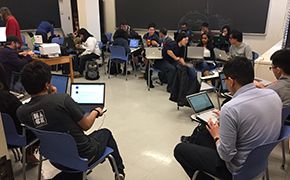Instructor Insights pages are part of the OCW Educator initiative, which seeks to enhance the value of OCW for educators.
Course Overview
This page focuses on the course RES.3-003 Learn to Build Your Own Videogame with Unity Game Engine and Microsoft Kinect as it was taught by Kyle Keane and Andrew Ringler in IAP 2017.
This course was a 9-day hands-on workshop about designing, building, and publishing simple educational videogames. Participants learned about videogame creation using the Unity game engine, collaborative software development using GitHub, gesture handling using Microsoft Kinect, 3D digital object creation, videogame design, and small team management.
The course was offered during the Independent Activities Period (IAP), which is a special 4-week term at MIT that runs from the first week of January until the end of the month.
Course Outcomes
- Learn fundamentals of videogame creation using the Unity game engine
- Become familiar with collaborative software development using GitHub
- Explore gesture handling using Microsoft Kinect
- Learn about 3D digital object creation
- Practice small team management skills
Technical skills take a long time to develop; you can’t turn people into developers in two weeks. But you can teach life skills in that time, so one of our goals for this experience is for participants to leave the workshop valuing themselves as learners.
— Kyle Keane and Andrew Ringler
Below, Kyle Keane and Andrew Ringler describe various aspects of how they teach RES.3-003 Learn to Build Your Own Videogame with Unity Game Engine and Microsoft Kinect.
Learn more! At the following Residential Digital Innovations page, you can learn more about how Dr. Keane and his team used the Microsoft Kinect as an educational tool.
This workshop puts the responsibility for learning on the learner. The instructors set that expectation from the get-go.
— Abraham, Professional
Below, four participants in RES.3-003 Learn to Build Your Own Videogame with Unity Game Engine and Microsoft Kinect share their impressions of the workshop and offer advice to future participants.
Assessment
Grade Breakdown
There were no grades associated with this course.
Curriculum Information
Prerequisites
No previous experience with computer programming or videogame design required.
Requirements Satisfied
None
Offered
Offered periodically
Student Information

Breakdown by Year
Mostly undergraduates, some graduate students and professionals
Breakdown by Major
50% electrical engineering and computer science, 50% other, including business development
Typical Student Background
More than 50% of participants came to the workshop without prior digital design experience; about 30% had no prior computer programming experience.
During an average week, students were expected to spend 3-12 hours on the course, roughly divided as follows:
In Class
- Met 5 times per week for 3 hours per session; 9 sessions total.
- Workshop sessions were hands-on, with participants collaborating to build videogames using the Unity game engine.
Out of Class (Optional)
Some participants continued to work on their projects outside of class.
Semester Breakdown
| WEEK | M | T | W | Th | F |
|---|---|---|---|---|---|
| 1 |  |  |  |  |  |
| 2 |  |  |  |  |  |
| 3 |  |  |  |  |  |
| 4 |  |  |  |  |  |
 No classes throughout MIT
No classes throughout MIT Workshop
Workshop No class session scheduled
No class session scheduled Public exhibition
Public exhibition


 Room 1 of 1
Room 1 of 1 